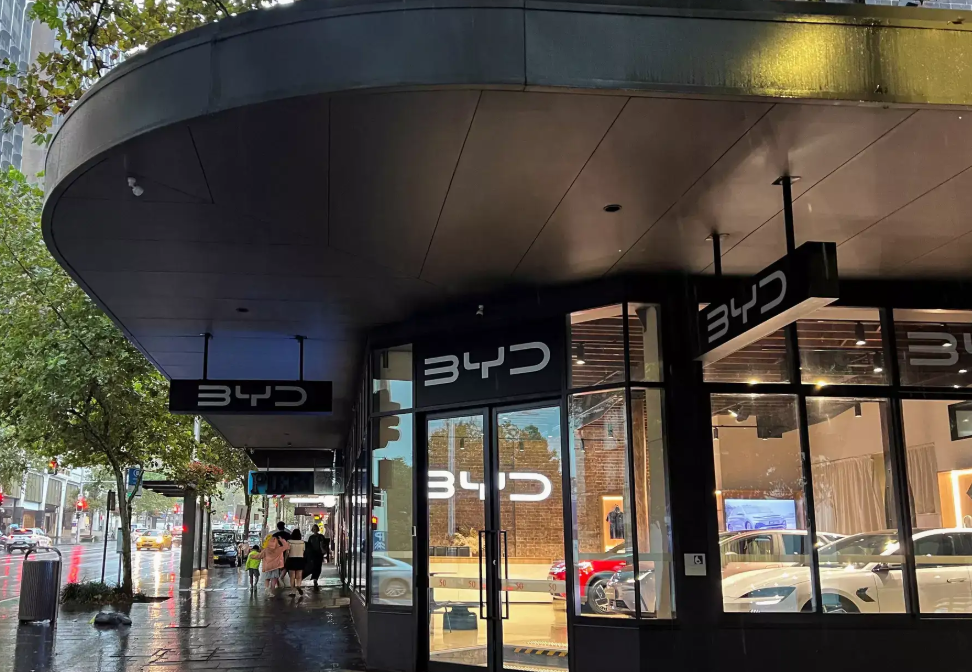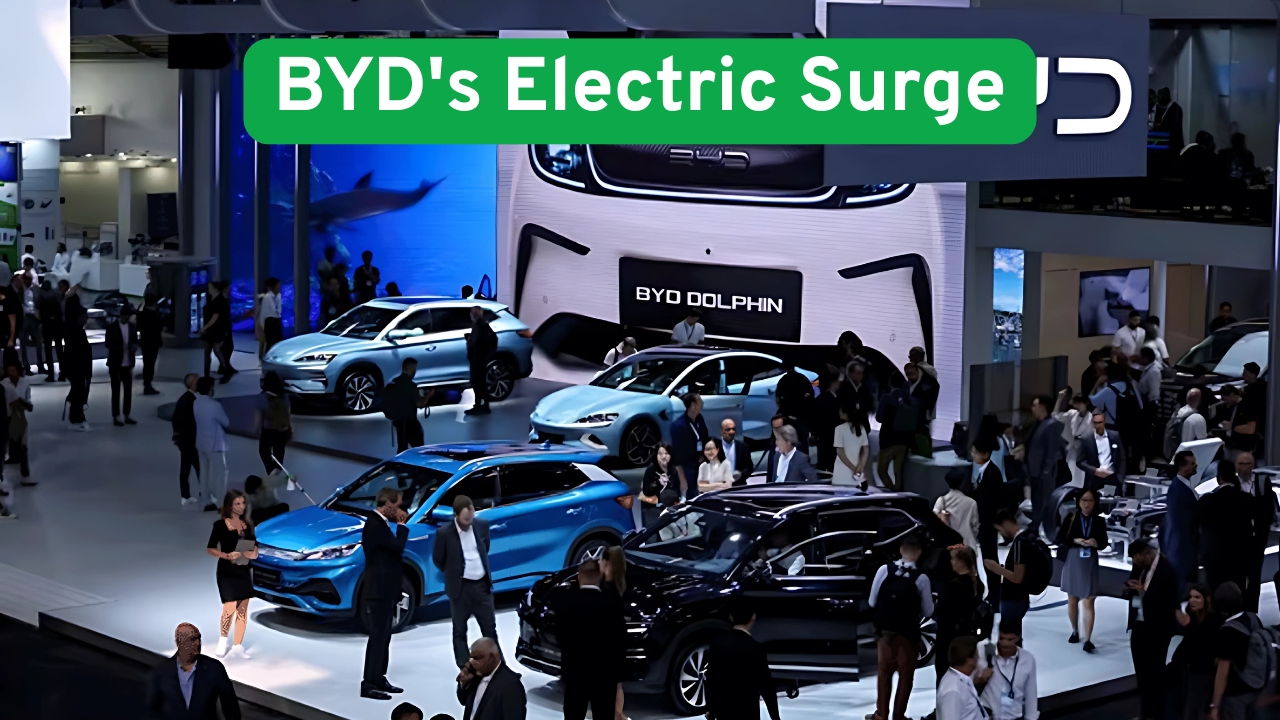BYD Fleet Sales in Australia: BYD is experiencing explosive fleet adoption in Australia, with ambitious plans to reach 50,000 sales in 2025 and potentially challenge Toyota by 2027. The Chinese EV giant has secured massive fleet partnerships, particularly with Uber’s 10,000-vehicle deal, while expanding into government and commercial sectors.
The BYD Fleet Revolution in Australia
Australia’s electric vehicle landscape is witnessing a dramatic shift, and BYD is leading the charge in fleet adoption. The Chinese automotive powerhouse has transformed from a market newcomer in 2022 to become the country’s second-largest EV brand. BYD now holds 14% of Australia’s EV market, trailing only Tesla’s 53%.
The numbers tell an incredible story of growth. BYD sold 12,438 vehicles in Australia in 2023, and by 2024, they had already doubled their sales trajectory. But here’s where it gets really exciting for fleet managers and businesses – BYD’s aggressive fleet-focused strategy is reshaping how Australian companies think about vehicle electrification.
Massive Fleet Partnerships Driving Growth
The Uber Game-Changer
The biggest fleet news of 2023 was BYD’s landmark partnership with Uber Australia. This partnership makes 10,000 BYD electric vehicles immediately available to Uber drivers and Uber Eats delivery people through flexible financing options.
Two financing options are available: ‘Full Ownership’ offers a path to own the BYD through longer-term financing, while ‘Flexi Ownership’ provides the option to return the vehicle after a minimum term. This isn’t just about cars – it’s about revolutionizing the gig economy.
Commercial Vehicle Expansion
BYD’s commercial ambitions extend far beyond passenger cars. In Australia, BYD has 200 buses on the road after partnering with major operators including Transit Systems, Ventura and Kinetic. The company’s D9RA chassis has become a proven solution for public transport electrification.
In 2024, BYD will release a new range of electric bus models including the Blade Battery chassis extending to city, school and midi buses, featuring greater seating capacity, longer range and lighter weight.
Government Fleet Adoption: The Slow But Steady March
Current Government Fleet Landscape

While BYD’s government fleet adoption is still developing, the foundation is being laid. BYD’s financing excludes government, fleet and rental buyers from their standard 6.65% P.A. finance offer, indicating they have separate, specialized government fleet programs.
Government fleet data shows that in 2023, while 630,297 vehicles were delivered to private buyers, 429,634 vehicles went to businesses and another 33,803 to government fleets. This represents a massive opportunity for BYD to capture.
Policy Support Driving Adoption
Australia’s government policies are creating the perfect storm for fleet electrification. Since coming to power in 2022, Prime Minister Anthony Albanese’s government has aggressively promoted EV adoption as part of the country’s plans to cut emissions.
State governments are also stepping up:
- Queensland, NSW, and Victoria have set 50% EV targets by 2030
- Generous rebates available for EV purchases
- Heavy investment in charging infrastructure
- New Vehicle Efficiency Standards coming in 2025
Business Fleet Success Stories
Ride-Share and Delivery Revolution
BYD’s strategy has been brilliant – target the high-mileage, cost-conscious fleet operators first. Two-thirds of Uber drivers want to switch to EVs, but the biggest barrier is the initial cost of the car. BYD’s flexible financing directly addresses this pain point.
Uber launched its first fully-electric product, ‘Comfort Electric’, available initially to Uber for Business customers in Sydney, Melbourne, Perth, Brisbane, Gold Coast and Adelaide. This premium electric ride service showcases BYD vehicles to corporate travelers daily.
Corporate Sustainability Programs
Businesses are embracing BYD for their sustainability goals. Uber for Business offers a Sustainability Dashboard that helps corporate customers track carbon emissions from travel data, supporting their sustainability initiatives.
The FBT EV exemption is assisting businesses with the higher price point of EVs, particularly for driver-assigned vehicles. This tax advantage makes BYD’s fleet proposition even more attractive.
The BYD Fleet Product Lineup
Current Fleet Champions
BYD Atto 3: Starting from $39,990 before on-road costs, this compact SUV offers 345-420km range and has become one of Australia’s most popular EVs. Perfect for urban fleet operations.
BYD Dolphin: Now starting from just $29,990, making it Australia’s cheapest electric car with 340-427km range. Ideal for cost-conscious fleet managers.
BYD Seal: Priced from $49,888 to $68,748, offering 460-570km range to compete with Tesla Model 3 in the premium fleet segment.
Game-Changing New Models
BYD Sealion 6 PHEV: Launched in May 2024, priced from $48,990, providing 92km electric range and 1100km hybrid range. This plug-in hybrid is perfect for fleets needing maximum flexibility.
BYD Shark 6 Ute: The PHEV ute entered showrooms with a special introductory price of $57,990 for the first 4000 units. With combined 321kW power and 5.7-second 0-100km/h time, it’s giving tradies a muscular EV option.
Fleet Pricing and Support Programs
Dedicated Fleet Pricing Structure
In October 2024, BYD announced fleet pricing across its range with free dealer delivery as part of the offer. Fleet buyers must register for the BYD Fleet Program through the brand’s dedicated online portal.
This dedicated approach shows BYD understands fleet buyers have different needs than private purchasers – volume discounts, specialized servicing, and flexible terms.
Service and Support Network
BYD has rapidly expanded its support infrastructure. The brand now has over 40 retail locations nationwide and offers servicing through over 40 mycar locations. Plans include expansion from 35 outlets to more than 70 by the end of 2024.
This nationwide coverage is crucial for fleet confidence – knowing your vehicles can be serviced anywhere reduces operational risk.
Ambitious Growth Targets
The Road to Market Dominance
BYD’s growth ambitions are staggering. The company sold 12,438 vehicles in 2023, aims to double that to 25,000 in 2024, and wants to double again to 50,000 in 2025. EVDirect’s Luke Todd has stated their target is to challenge Toyota for the number-one spot by 2027.
To become a top-five brand, BYD would need to sell more than 70,000 vehicles annually, while beating Toyota would require over 241,296 sales. These aren’t modest goals – they’re revolutionary.
Product Pipeline for Fleets
BYD plans to launch up to five new models annually. The dramatic model expansion will be accompanied by a 500% lift in marketing spend. For fleet buyers, this means constantly improving choice and competitive pricing.
Confirmed future models include the BYD Atto 2 and BYD Tang L, expanding options for different fleet requirements.
Challenges and Opportunities
Infrastructure and Range Concerns
Charging infrastructure remains the biggest challenge. Chris Forbes from Kia noted that most customers are working through their individual charging requirements, and the tipping point is still a few years away.
However, solutions are emerging: home charging leads the way, workplace charging is being considered as a staff incentive, and kerbside charging could provide ‘near home’ solutions.
Cost vs. Benefit Analysis
The financial equation is increasingly favorable. EVs save around $3,000 every year in running costs, with even greater savings for those traveling further in regions and outer suburbs. For high-mileage fleet vehicles, these savings add up quickly.
Luke Todd from EVDirect highlighted the potential savings: “What excites me the most is the amount of money drivers and delivery people can save by switching to electric, given the number of kilometres they drive each day”.
Industry Expert Perspectives
Fleet Manager Insights
Industry experts predict steady growth: “Cox Automotive forecasts EV sales growth from 7.7% market share in 2024 to more than 10% in 2025, underpinned by the boom in Chinese products from BYD and MG”.
Giles Belcher from MG Motor Australia notes: “With great choice, growing range, and reduced prices, fleets will continue to move towards EVs in 2025”.
Regulatory Environment
New regulations are accelerating adoption. The New Vehicle Efficiency Standards and carbon reporting laws are among the biggest factors influencing fleet purchasing decisions, pushing companies toward lower-emission vehicles.
Global Context and Competition
International Success Story
BYD’s Australian success reflects global trends. Globally, BYD sold 4.27 million vehicles in 2024, a massive 41.3% jump over 2023. The company’s partnership with Uber extends across key global markets, with plans for 100,000 new BYD electric vehicles on the Uber platform worldwide.
Competitive Response
Traditional automakers are responding. Ford has two electrified vehicles in the Australian market with three more coming, while Toyota has launched its first electric car alongside nine hybrids. The competition is heating up, which benefits fleet buyers through better choice and pricing.
FAQs About BYD Fleet Sales in Australia
Q: How many BYD vehicles are currently in Australian fleets?
A: BYD has partnerships providing 10,000 vehicles to Uber alone, plus 200 buses with major operators and growing commercial sales.
Q: Does BYD offer special pricing for fleet buyers?
A: Yes, BYD launched dedicated fleet pricing in October 2024 with free dealer delivery for registered fleet program participants.
Q: What government incentives support BYD fleet adoption?
A: The FBT EV exemption assists businesses with higher EV costs, particularly for driver-assigned vehicles.
Final Takeaway: BYD’s fleet strategy in Australia is working brilliantly. By focusing on high-mileage users like ride-share drivers, delivery operators, and cost-conscious businesses, they’ve created a blueprint for EV adoption that other manufacturers are scrambling to match. With nearly 1 in 4 EVs sold in Australia in 2024 being a BYD, and sales expected to double again in 2025, the brand is positioned to fundamentally reshape Australia’s fleet landscape.

